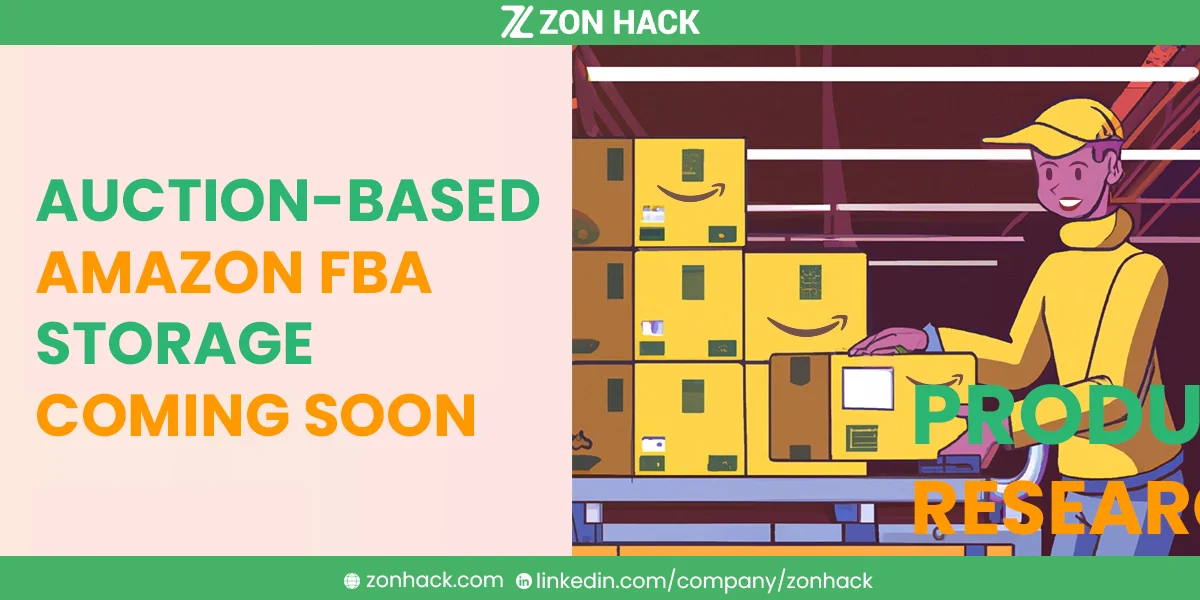Amazon now offers extended storage capacity beyond previous inventory limits by turning its Fulfillment by Amazon (FBA) to auction bidding, starting on March 1st, 2023. It’s most likely runnable like an Amazon PPC campaign. Amazon is going to move towards an auction-based system, which means inside Amazon, if you want to get that extra 50 cubic foot capacity, you bid 50 bucks, but the next seller bids 60, so that seller will pay 51 dollars, just like an auction-based PPC campaign. Based on Inventory Performance Index (IPI) scores and sales performance, Amazon frequently evaluates sellers’ performance in the marketplace and sets the maximum inventory storage accordingly.
Amazon’s FBA program is an enormous benefit for brands who sell on Amazon; thus, over 90% of top sellers use it; also, without FBA, selling on Amazon is almost impossible. Over the last few years, sellers have faced the necessity for more space, predictability, and control over inventory. Amazon’s new auction system will help sellers with those challenges and so much more.
With this new update, Amazon will provide estimated storage limits for the upcoming two months to assist sellers in planning over a long time. Dharmesh Mehta, Vice President of Amazon Worldwide Selling Partner Services, stated in a recent blog post highlighting the announcement, “We will forecast how much space and labor we expect to have to provide these estimates, but these estimates may vary up or down based on how efficiently sellers are using their capacity, as measured by Inventory Performance Index (IPI) score.”
With this new Capacity Manager in place, sellers can request an increase in their capacity limits for products popular with customers based on a reservation fee. Mehta noted…
“Requests are granted objectively, starting with the highest reservation fee per cubic foot until all capacity available under this program has been allocated. When additional capacity is granted, sellers’ reservation fees are offset by earning performance credits from the sales they generate using the extra capacity. Performance credits are designed to offset up to 100% of the reservation fee, so sellers don’t pay for the additional capacity as long as their products sell through.
Our goal is to provide sellers with more control over how much space they can have while limiting unproductive use. We’ve piloted this feature with certain US sellers, and we’re excited that with this launch, we will expand it so all sellers can request higher FBA capacity limits.”
The announcement goes on to highlight how Amazon will set storage limits and measure inventory usage in cubic feet vs. number of units. This will better estimate the capacity of inventory use in Fulfillment Centers and transportation vehicles. Amazon will provide an estimate of how many units specific cubic volume capacity are permitted for sellers who prefer to deal in units.
Bidding for Extra Space
Amazon’s Capacity Manager help page reads, “If you have FBA capacity limits but could use more capacity for products that you expect to be popular with customers, you can request an increase to your capacity limits.”
The page also added, “In your request, specify the following: How much additional capacity you want for the specified period (up to 20% of your initial limit or 2,000 cubic feet, whichever is greater) and maximum reservation fee that you’d be willing to pay for the extra capacity.”
Given this formula, if the seller only has 500 cubic feet of storage space, they can bid for extra space at $0.10 per cubic foot. Amazon will consider the requests case-by-case, and there’s no guarantee they will be granted that additional storage space. Amazon will allocate sellers with the highest bid that extra capacity in the first place.
Amazon states, “Our criteria for granting requests is completely objective. We start with the highest reservation fee and continue in this order until all allocated capacity has been granted. The capacity granted will be available to you for the entire period specified. This additional capacity may also be available to you for up to one month before the requested so you can create shipments to send inventory to Amazon’s fulfillment centers so it can be pre-positioned in our network during the period you requested.”
Reimbursing Storage Fee Through Productive Use
Sellers can reimburse the fees paid for the additional capacity besides the control and predictability over inventory levels. If the seller becomes successful with the extra (bid upon) inventory, there is a chance to earn performance credit and get a refund of their reservation fee. According to Amazon, “You will earn a $0.15 performance credit for every dollar of sales you generate using this additional capacity during the period requested. We designed this credit to give you the opportunity to offset 100% of the reservation fee if you use the additional capacity productively.”
These changes are likely to help sellers get more space and generate more revenue when their forecasts are better than Amazon’s limit system. If the seller could achieve more sales using that extra space, Amazon will allow an extended limit, and the seller will not be required to bid for the additional space next month.
Pros and Cons of the Auction System
The new auction service is helpful, especially to sellers with larger products. A single, month-long storage capacity limit is designed to streamline inventory management. This change can address some major customer issues and make it easier to determine how much inventory to procure and manufacture.
You can plan three months in advance with estimated capacity limits. Estimates vary on how efficiently you use capacity, as measured by your IPI score.
One negative side of this new program is that sellers might lose even more margin on fees. Albeit, an Amazon spokesperson said that to date, most sellers have had their total reservation fee recouped.
Thoughts on the New FBA Capacity System
Auctions are known as surge or dynamic pricing to resolve supply and distribution mismatches for many brands. Google and Disney also accepted dynamic pricing besides the airline industry. Amazon is one of the most noteworthy companies that follow dynamic pricing. Amazon diverting to cubic foot measured storage limits is said to minimize previous issues for many sellers in maintaining healthy inventory levels. On the other hand, small sellers are likely to get the opportunity to store more products than before and are allowed to bid on a smaller amount of space. The new announcement from Amazon is an intelligible initiative to encourage small businesses on the platform.




